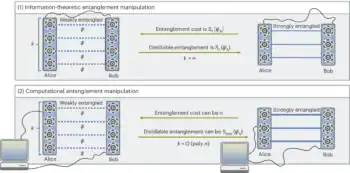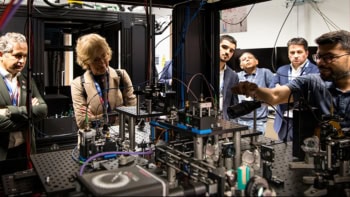
“Negative time” might sound like science fiction, but an international team of theorists and experimentalists has determined that a photon can, in fact, spend a negative amount of time in an excited atomic state while passing through a cloud of atoms. The finding could have applications in studies of light-matter interactions and quantum sensing – though not, alas, in time travel or other sensational effects.
Quantum mechanics has produced a lot of weird results, and the latest originated in 2022 with an experiment conducted by physicists at the University of Toronto, Canada. Led by Aephraim Steinberg, they found that when a photon passing through a cloud of atoms excites an electron in one of the atoms, it seems to spend a similar amount of time in this atomic excitation as a photon that passes straight through the cloud, apparently without exciting an atom at all.
A theoretical framework
To understand the theory behind this counterintuitive result, Steinberg and colleagues worked with researchers from the Massachusetts Institute of Technology in the US, Griffith University in Australia, and the Indian Institute of Science Education and Research. The framework they developed, which they now describe in APL Quantum, involves a single photon being sent into an atom cloud that is continuously monitored with a so-called “weak probe” that detects the presence of an atomic excitation anywhere in the cloud. Integrating this weak-probe signal over time thus provides a measure of how long the photon spends in an excited atomic state before it leaves the atom.
After crunching the numbers, the researchers made a prediction that surprised even them: the average excitation time can be negative. They also found that this excitation time should be the same as another, more familiar, time known as the group delay.
The team’s lead theorist, Griffith’s Howard Wiseman, says it is important to distinguish between these two times. A negative group delay, he observes, can be explained in a relatively intuitive way. Because the front of the photon pulse exits the atom cloud before the peak of the pulse enters it, and the peak never exits because most of the photons are scattered, there is, he says, an “illusion” that the photons leave the medium before they arrive.
However, he continues, what this framework actually measures is the time a transmitted photon spends in the atom cloud. It says nothing about whether such a photon excites an atom on its way through the cloud. Although it is normally assumed that any photon that excites an atom gets randomly scattered and never reaches the detector, says Wiseman, “We now say that this is not true and forward-scattered photons actually contribute a lot to the average measurement”.
Real-time measurements
To test this theory, Steinberg and colleagues set up a new experiment that sends two counter-propagating laser beams into a cloud of 85Rb atoms that have been cooled to 60–70 µK. The first beam contains the photons that may give rise to atomic excitation and may be either transmitted or scattered. The second beam is used for the weak measurements and detects the presence of an excitation via tiny shifts in its phase. These measurements required a high level of stability and a low level of interference in all parts of the setup.
After refining their system, the researchers measured average atomic excitation times for transmitted photons ranging from (–0.82 ± 0.31)𝜏0 for the most narrowband pulse to (0.54 ± 0.28)𝜏0 for the most broadband pulse. Here, 𝜏0 is the excitation time averaged over both scattered and transmitted photons, which is always positive and ranges from 10–20 ns, depending on various parameters. This result shows that negative excitation times do indeed have a physical reality in quantum measurements.
A matter of time
According to Steinberg, while he and his colleagues previously knew that negative numbers could pop out of the mathematics, they tended to sweep them under the rug and make excuses for them, assuming that while they correctly described the location of a peak, they weren’t physically relevant. “I am now led to revisit this and say: those negative numbers appear to have more physical significance that we would previously have attributed to them,” he tells Physics World. As a result, he hopes to “begin to investigate more deeply what we think the meaning of a ‘negative time’ is”.

‘Strange history’ of photons challenges our understanding of quantum interactions
Jonte Hance, a quantum physicist at Newcastle University, UK, who was not involved in this research, warns that interpreting negative time too literally can lead to paradoxes that aren’t necessary for the physics to work. Nevertheless, he says, the “anomalous” values recorded in the weak measurement “point to something interesting and quantum happening”.
Hance explains that in his view, a negative value for the mean atomic excitation time for transmitted photons implies contextuality – a property of quantum systems whereby measuring the system in different ways can make it look like it has incompatible properties if we assume that measuring the system does nothing to it. “Contextuality seems to be one of the tell-tale signs a quantum scenario may provide us with an advantage at a certain task over all possible classical ways of doing that task,” he says. “And so it makes me excited for what this could be used for.”



